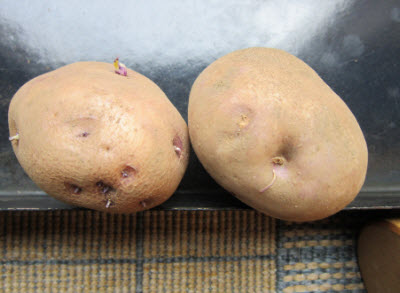April is the beginning of the busy season for me. The snow is gone and the garden beckons, but high on my list is to spring-clean the chicken coop. It needs to be done every year! Here’s how to deep-clean the coop.
Once a year, everything gets thoroughly cleaned from top to bottom: shoveled, swept, vacuumed and washed. Everything in it comes out and gets scrubbed down before being allowed back in.
I put a few nesting boxes under the coop outside so the girls have a place to lay their eggs. Then I shut their door to the outside—so they can’t get back inside. They don’t like it much, but this thorough cleaning is a major key to the health and well-being of the chicken and keeping them free from parasites, mold, and mildew.
(See a free beginner’s guide to raising chickens.)
Chickens are dusty. Their scratch and peck habit constantly agitates the floor and the dust bunnies land in all the crevices and on all the flat surfaces of the coop. So, after everything vacates the premises, I tackle the job:
- Remove nesting boxes.
- Shovel the used bedding into the compost pile.
- Sweep the cobwebs, windowsills, and shelves,
- Vacuum the entire building.
- Power-wash the whole place.
- Hand scrape all of the leftover poop on the floor and throw in a bucket of sudsy water treated with a half bottle of hydrogen peroxide. Spreading it all around with a broom, I make sure that the soapy water gets all over the floor.
- Then it’s rinse, rinse, rinse.
- If the smell isn’t gone after one application, I give it another. It’s really important to get the odor out even though it will be coming right back in a few short days.
- The nesting boxes also get scrubbed down as do all of the containers, lights, feeders and any other paraphernalia.
- Everything gets set out to air dry and I sit for a few minutes. This is my most physical day of the year. It’s a big job and I always get at least some help.


When everything is dry, it all goes back into the coop. Two bales of new wood shavings are placed on the floor and the nesting boxes are returned to their shelves. Now the girls can get back to business!

After this chore is done, it’s time to begin planting the garden. Here in New England, there are many crops that don’t mind the cold weather so I begin with these doing one bed at a time. So far, I’ve planted the snow peas and our first planting of lettuce.
(If you’ve already done your planting, take tips for succession planting!)
I plant lettuce every ten days to two weeks all summer long as it gets bitter when it gets big and it’s my husband’s favorite crop. I get the whole bed ready, but just plant one section marking the area with a shell. See more planting lettuce.


Next will be any one of a number of veggies. Since I live in an area that gets frost, I plan veggies that don’t mind a bit of frost and can be planted sooner rather than later: peas, brussel sprouts, broccoli, cabbage, Napa cabbage, beets, carrots (although it’s best to wait until after May 20 where I live or cover them), parsnips, turnips, rutabaga, radishes, Swiss chard, kale, leeks, pansies and snap dragons.
See all free vegetable guides for advice on planting, growing, pests and harvesting.
Right now, I have my potatoes “greening.” I spread them out right side up (the down side is where the potato was originally connected to the vine—the right one in this photo).

I put mine in a tray. It’s important to put them in a bright, but NOT sunny place for ten days to two weeks before planting them in the ground. This encourages them to begin to sprout and will help improve yields.

The onions will be going into the ground soon as well. I generally plant them near the end of April.
So, it’s time to get going! Happy planting!

 TABLE OF CONTENTS GOES HERE
TABLE OF CONTENTS GOES HERE















